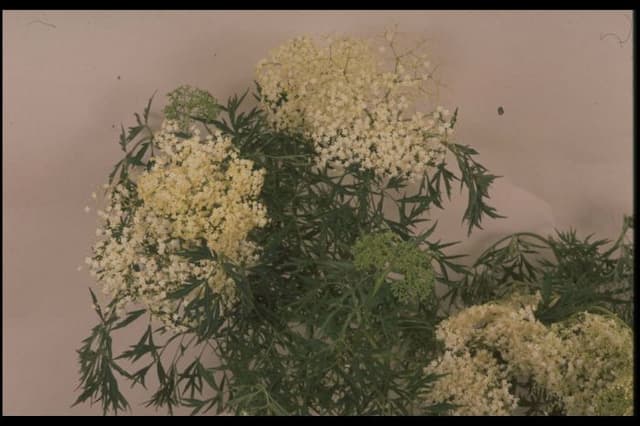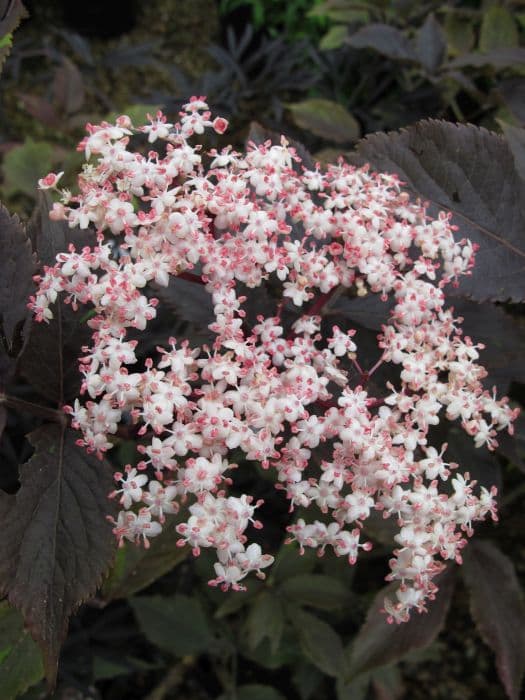Possumhaw Viburnum Viburnum nudum 'Pink Beauty'

ABOUT
The Viburnum nudum 'Pink Beauty' is an ornamental shrub known for its attractive foliage and berries. Throughout the seasons, it showcases a variety of colors, adding interest to gardens. During the spring, the plant bears clusters of small, creamy-white flowers that provide a subtle and delicate fragrance, which can be a magnet for pollinators like butterflies and bees. As the plant transitions into summer, the foliage remains a glossy, deep green, giving it a rich and vibrant appearance. The true visual spectacle begins when the flower clusters begin to transform into berries. Initially, the berries are a pale pink, hence the name 'Pink Beauty'. As the berries mature, they go through a striking metamorphosis in color, shifting from bright pink to deep blue, then eventually to a dark, almost purplish-black which can provide a lovely contrast against the green leaves. In the fall, the leaves of 'Pink Beauty' change to stunning shades of purple and red before shedding, which contributes to the plant's multi-season appeal. The look of 'Pink Beauty' is full and lush, with a rounded form. The leaves are ovate, smooth-edged, and have a somewhat leathery texture. Its presentation makes it an ideal candidate for a garden focal point or as part of a hedge or mixed border that benefits from seasonal color changes.
About this plant
 Names
NamesFamily
Adoxaceae
Synonyms
Smooth Witherod, Possumhaw, Wild Raisin, Smooth Viburnum
Common names
Viburnum nudum 'Pink Beauty'.
 Toxicity
ToxicityTo humans
The Viburnum nudum, commonly known as Possumhaw, is not typically considered toxic to humans. However, consuming parts of this plant, especially in large quantities, may potentially cause mild stomach upset. While serious poisoning is not expected, it's advisable to avoid ingesting this plant and to keep it away from small children who might accidentally chew on it.
To pets
The Possumhaw is generally considered non-toxic to pets. It is unlikely to cause serious harm if pets nibble on it, but as with any non-food plant, ingestion of leaves or berries in significant amounts could potentially result in gastrointestinal irritation, vomiting, or diarrhea. To be safe, it is best to prevent pets from consuming this plant.
 Characteristics
CharacteristicsLife cycle
Perennials
Foliage type
Deciduous
Color of leaves
Green
Flower color
White
Height
5-6 feet (1.5-1.8 meters)
Spread
5-6 feet (1.5-1.8 meters)
Plant type
Shrub
Hardiness zones
5-9
Native area
North America
Benefits
 General Benefits
General Benefits- Attractive Flowers: Produces lovely pink blossoms that add aesthetic appeal to gardens.
- Wildlife Habitat: Berries provide a food source for birds, attracting wildlife to the area.
- Four-Season Interest: Offers year-round visual interest with flowers, berries, and colorful foliage.
- Easy to Grow: Tolerates a range of soil types and conditions, making it easy to care for.
- Durable: Possesses a good resistance to pest and disease issues, reducing the need for chemical treatments.
- Native Adaptation: As a native species, it is well-adapted to local climates and eco-systems, supporting biodiversity.
- Privacy Screening: Can be used as a hedge or screening plant to provide privacy in landscapes.
- Fall Color: Leaves change to stunning colors in autumn, contributing to the seasonal charm of the landscape.
 Medical Properties
Medical PropertiesThis plant is not used for medical purposes.
 Air-purifying Qualities
Air-purifying QualitiesThis plant is not specifically known for air purifying qualities.
 Other Uses
Other Uses- Photography Subjects: The striking berries of Viburnum nudum 'Pink Beauty', which change from pink to blue, make it an excellent subject for photographers, particularly those interested in botanical or nature photography.
- Wildlife Shelter: This shrub provides excellent cover and nesting opportunities for birds and small mammals seeking shelter within its dense foliage.
- Educational Resource: Botany and horticulture students can study this plant to understand hybrid vigor and the impacts of selective breeding on shrub characteristics.
- Craft Material: The sturdy branches of Viburnum nudum 'Pink Beauty' can be used in basket weaving or as a natural base for handmade wreaths.
- Dye Production: The leaves and berries may be used to produce natural dyes for fabrics or crafts, offering varying shades based on the mordant used.
- Winter Garden Interest: With its persistent fruits and attractive winter silhouette, it adds visual interest to gardens during the dormant season.
- Boundary Planting: Due to its dense growth habit, it can be planted as part of a mixed hedgerow to mark property lines naturally and attractively.
- Backdrops for Smaller Plants: It serves as an ideal backdrop in a mixed border, allowing foreground plants to stand out against its foliage and berries.
- Theme Gardens: Perfect for inclusion in native plant gardens or wildlife gardens designed to support local ecosystems and biodiversity.
- Soil Stabilization: The root system helps to prevent soil erosion on slopes and can be used in rain gardens to manage runoff in a sustainable way.
Interesting Facts
 Feng Shui
Feng ShuiThe Viburnum is not used in Feng Shui practice.
 Zodiac Sign Compitability
Zodiac Sign CompitabilityThe Viburnum is not used in astrology practice.
 Plant Symbolism
Plant Symbolism- Regeneration and Renewal: The Viburnum shrub, also known as the Possumhaw, often symbolizes renewal because it has the ability to regenerate after harsh winters, representing hope and the continuity of life.
- Protection: In some cultures, Viburnum species are planted around homes to offer protection, as the dense growth habit of the shrub is thought to shield houses from negative energies.
- Femininity and Fertility: With its delicate pink flowers, 'Pink Beauty' Viburnum is occasionally associated with femininity and fertility, celebrating the beauty of life and creation.
- Abundance: The bountiful clusters of berries on Possumhaw can symbolize abundance and prosperity, hinting at the richness of the natural world.
- Perseverance: Capable of thriving in various conditions, Viburnum nudum 'Pink Beauty' can also be a symbol of perseverance and the ability to overcome obstacles.
 Water
WaterFor the Possumhaw Viburnum, it's important to maintain consistent moisture, especially in the first growing season to establish a deep, extensive root system. Water the plant deeply, applying about 1 inch of water once a week. During the hot summer months or in periods of drought, increase watering to twice a week. Ensure that the soil is moist but not soggy, as overwatering can lead to root rot. Adjust the watering frequency based on rainfall, lessening it during wet seasons.
 Light
LightPossumhaw Viburnum thrives in full sun to partial shade. The best spot would be where the plant can receive at least 4 to 6 hours of direct sunlight daily, with some shade during the hottest part of the afternoon to protect the leaves from scorching.
 Temperature
TemperaturePossumhaw Viburnum is hardy and can tolerate a range of temperatures, making it suitable for many gardens. It can survive minimum temperatures down to about -10°F and is comfortable in the climate up to zone 5. The ideal temperature for promoting optimal growth and flowering is between 60°F to 75°F during the growing season.
 Pruning
PruningPrune the Possumhaw Viburnum to maintain shape and remove any dead or damaged branches, which encourages healthy growth and air circulation. The best time to prune is immediately after the plant has finished flowering to avoid cutting off the next year's buds. Generally, pruning once a year is sufficient.
 Cleaning
CleaningAs needed
 Soil
SoilPossumhaw Viburnum thrives in moist, well-drained acidic soil with a pH of 5.5-6.5. A mix of peat moss, compost, and pine bark will provide the ideal growing conditions, ensuring good drainage and fertility.
 Repotting
RepottingPossumhaw Viburnum, as a larger shrub, is usually not repotted often. It's commonly repotted or transplanted in the landscape every 3-5 years, as needed when it outgrows its space.
 Humidity & Misting
Humidity & MistingPossumhaw Viburnum is tolerant of a wide range of humidity conditions; it does best when the surrounding humidity is moderate to high but will adapt to average outdoor conditions.
 Suitable locations
Suitable locationsIndoor
Provide bright light, keep moist, ensure good air flow.
Outdoor
Plant in sun to part shade, keep soil moist.
Hardiness zone
5-9 USDA
 Life cycle
Life cycleThe life cycle of Viburnum nudum 'Pink Beauty', commonly known as the Smooth Witherod, begins with germination, as the seeds sprout when exposed to the appropriate conditions of moisture and temperature. Following germination, the seedling stage sees the development of primary leaves and root systems. As the plant enters the vegetative stage, it experiences significant growth in stems, leaves, and root systems, preparing for photosynthesis and further development. During the flowering stage, 'Pink Beauty' produces clusters of creamy-white flowers which, if successfully pollinated by insects, will give way to fruit. The fruiting stage is characterized by the development of its distinctive berries, which change from green to pink and then to a blue-black color. At maturity, the plant can spread by producing suckers, and its seeds are dispersed by birds that feed on its fruit, allowing the cycle to begin anew with the next generation of Smooth Witherod.
 Propogation
PropogationPropogation time
Spring to Summer
The Viburnum nudum 'Pink Beauty', commonly known as Smooth Witherod, is typically propagated by softwood cuttings during the late spring or early summer when the plant's new growth is still tender and green. This method is popular for its relative ease and effectiveness. To propagate by softwood cuttings, one would cut a section of the stem about 4 to 6 inches (10 to 15 centimeters) long, making the cut just below a leaf node. The lower leaves are removed, and the cut end is often dipped in rooting hormone to encourage root development. The cutting is then placed in a well-draining potting medium and kept moist until roots have formed, which usually takes several weeks. During this time, providing a humid environment by covering the cuttings with a plastic bag or dome can help prevent moisture loss and improve the chances of successful rooting. Once the roots are established, the new plant can be gradually acclimated to normal growing conditions and eventually transplanted outdoors.









